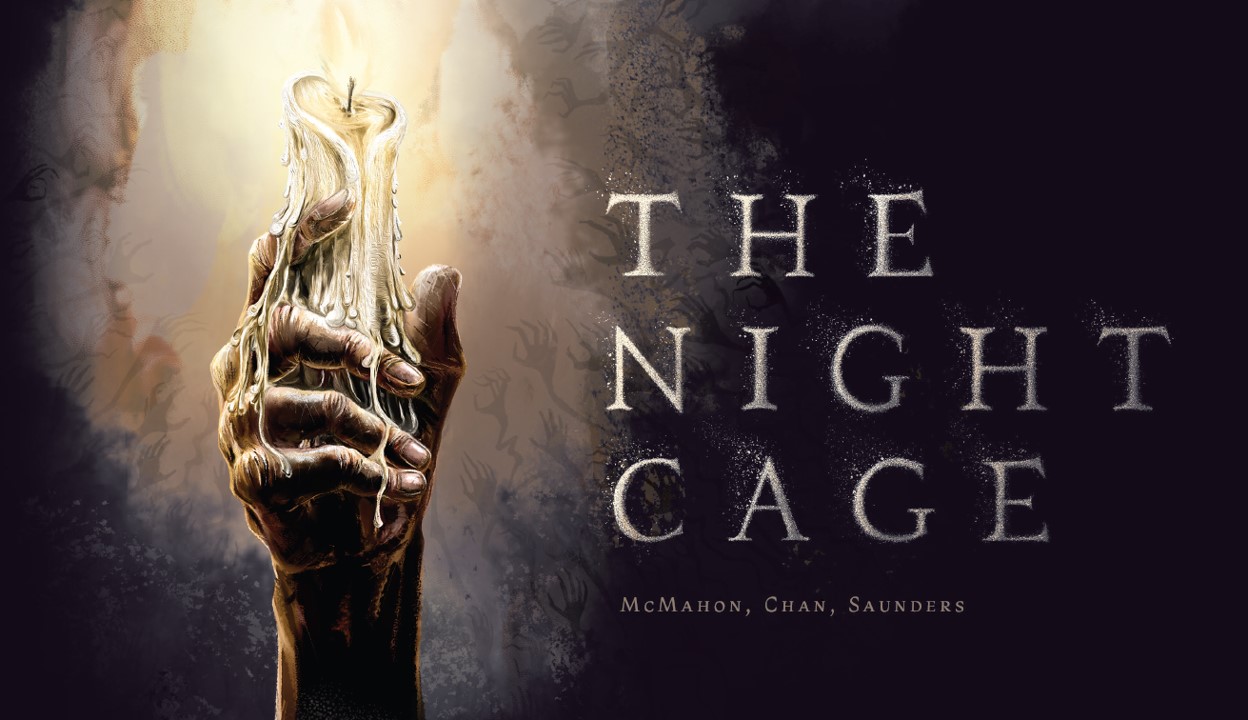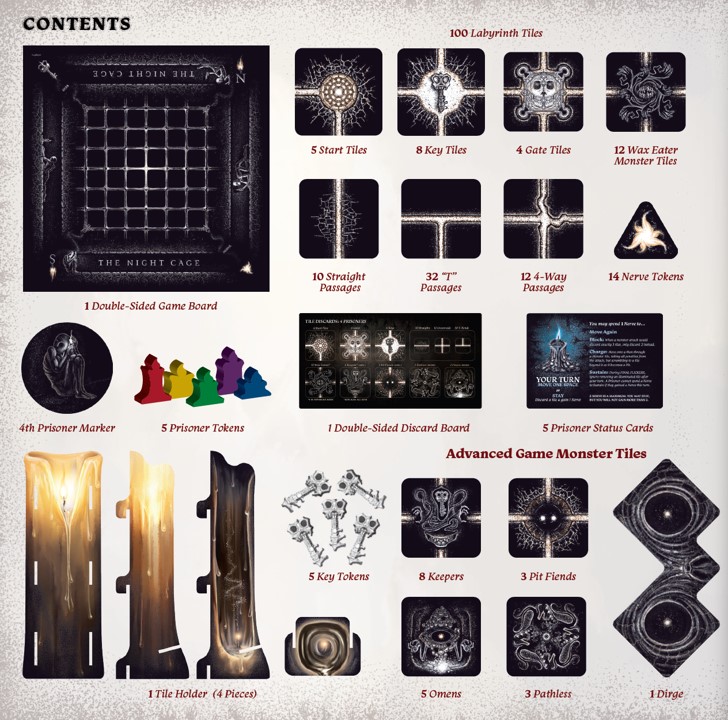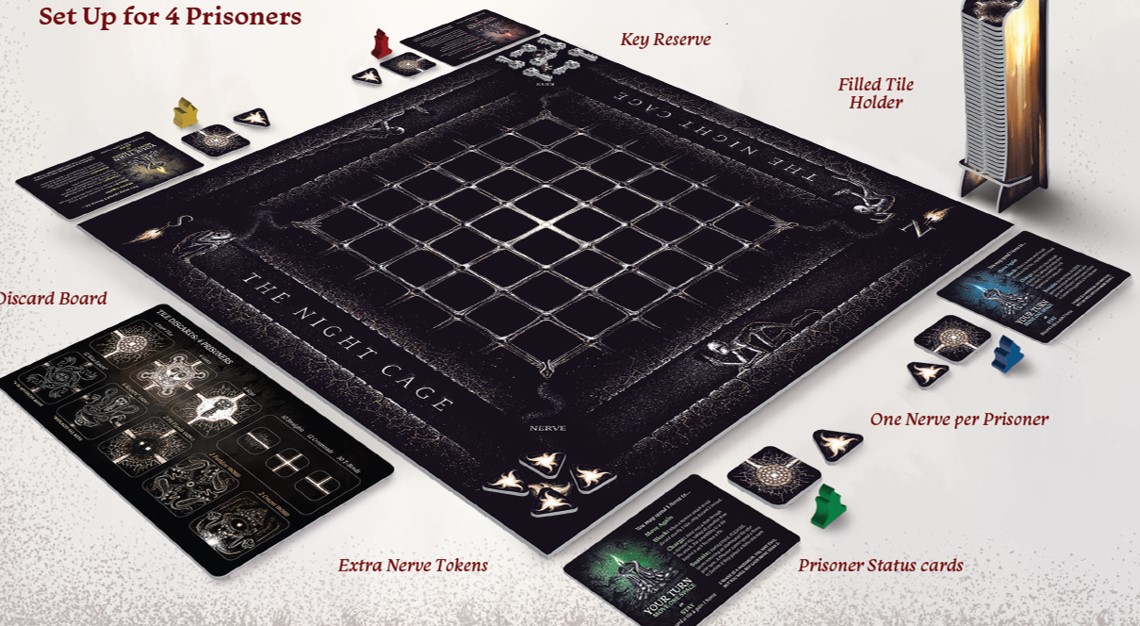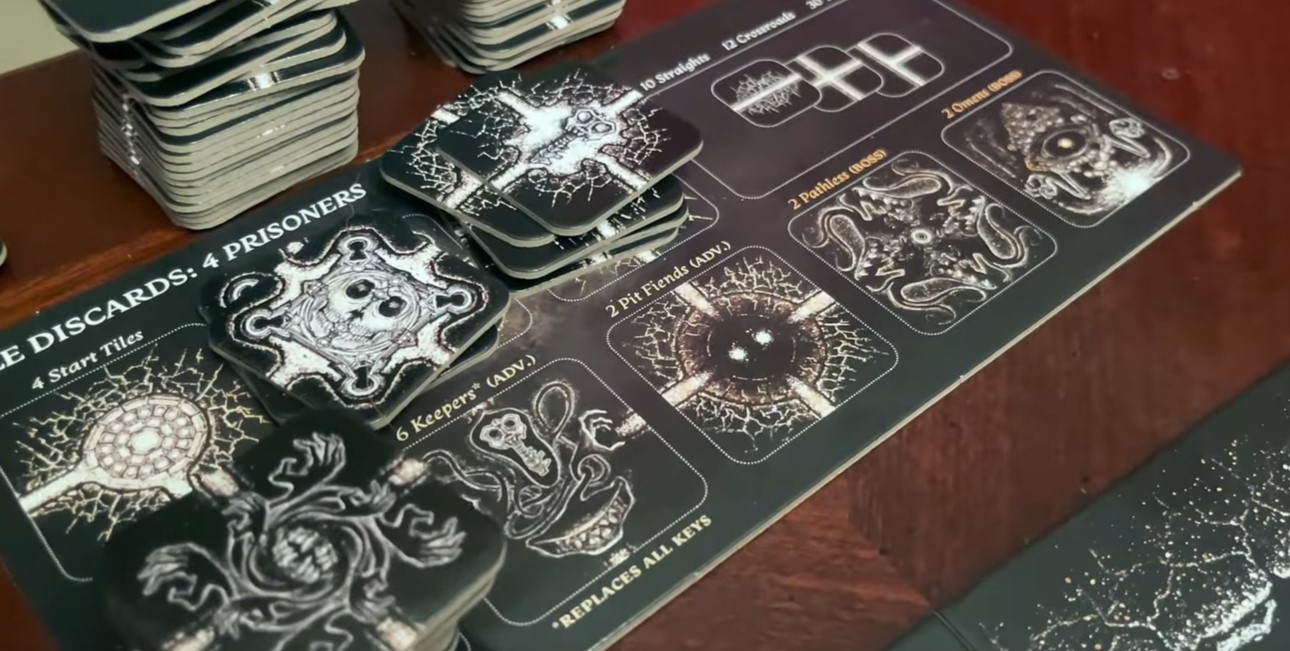Have you ever seen the movie, “Cube”? Prisoners awakening to find themselves trapped in some sort of strange environment, only to realize later how deadly it is? “The Night Cage” gave me those vibes, but only if it were Cthulhu running things instead of a high-level secret organization. In this (literally) dark cooperative game, 1-5 players will attempt to each get a key and converge on the same gate before their finite stack of room tiles expire. Essentially, you’ll be crawling through the darkness armed only with a candle…what could go wrong? Special thanks to Kurt over at Smirk & Dagger Games for providing me with the base copy of the game for review purposes, as well as Jondi over at OffDutyNinja, LLC for providing the Shrieking Hollow Expansion. I’ll opt to cover the latter towards the end of the article.
1-5 Players, Ages 14+, Average Play Time = 60-90 Minutes
—
Setup Overview
In a 1-4 player game, 4 prisoners are used and in a 5 player game, all 5 prisoners are used. In a 1-3 player game, there are rules outlining how to switch off and take turns while in a 4 player game, each player gets assigned a prisoner. Players set up the prisoner status cards (candle lit side up) of the matching prisoner token colors and start with one nerve token & a start tile.
There are various ways to setup the game depending on which extra monsters and boss tiles you want to include to increase your difficulty. The advanced content should be excluded for your first couple of runs to get a feel for the game.
The draw stack of room / monster tiles are placed in the candle tile holder, but in a special way that ensures that no monster tiles spawn in the opening part of the game. This stack of tiles is your life force, but you’ll need to find key & gate tiles so exploration is necessary.
You can learn more by visiting the official Smirk & Dagger Website and downloading the rules. The developer also was kind enough to go over “The Night Cage” with us in a demo video, a link to which is located at the end of this article.
—
Gameplay Overview
Players start by placing their starter tile anywhere on the board followed by their currently controlled player token. Since players start with their candle lit, they immediately draw & place tiles extending from the empty paths one at a time. A player can’t draw a new tile until the one just drawn is locked into place. This is important, as monsters can and will spawn so tile placement order does matter. Luckily, setup ensures no monsters will be drawn during every prisoner’s first turn.
A note on candles: If a prisoner’s candle is lit, they will automatically reveal new tiles after moving and thus illuminate adjacent rooms, preventing them from going away. If a prisoner’s candle is out, they must move blindly onto a newly drawn tile and do not illuminate adjacent rooms. Adjacent prisoners can automatically light a nearby prisoner’s candle.
Once on the board, each player will move a prisoner in turn. On a prisoner turn, they either stay or move.
STAY – Gain a nerve token and discard a tile from the candle room stack. Staying on a crumbling tile will trigger its collapse. Monster attacks are not triggered as there is no movement. A prisoner with lights out cannot stay without spending nerve.
MOVE – Move the prisoner to one adjacent, orthogonal space. Spaces are too small to be shared with other prisoners. Once moved, a prisoner will reveal tiles onto available, adjacent paths assuming their candle is lit. Tiles no longer illuminated by players are removed…this maze is an ever-changing one!
Monsters are part of the tile stack and will come out at some point. Wax eaters are the default monster and in summary, are motion activated. They attack in all orthogonal directions when anyone moves into or out of their line of sight. A prisoner unlucky enough to get hit loses the light on their candle and must discard three tiles from the tile stack.
Nerve is a resource that can be spent to do a number of things: move again, stay when lights out, discard two tiles instead of three during an attack, charge onto a monster tile, and skip removing tiles during the Final Flickers phase.
Final Flickers: When the draw stack runs out, no new tiles are added to the board after movement and each prisoner must voluntarily remove one additional tile (after removing those no longer illuminated).
Win/Lose: Players win if each prisoner gets a key (by going onto a key space) and they converge on the same gate tile (the only tile that shares spaces). Players lose if all gates have been lost, can’t each collect a key, and/or can’t achieve victory before the darkness takes them in Final Flickers.
There’s more to the game, but I’ll leave you to discover the ins and outs using the rulebook:
https://www.smirkanddagger.com/product-page/the-night-cage
—
Review
Dark, scary…Aidalee and I really felt the atmosphere on this one. I compared this game to “Cube” in my opening paragraph and I’m a sucker for psychological horror movies, so it comes to no surprise that I was attracted to this game right from the beginning. You don’t even need the advanced monsters or the expansion to experience the thrill, but you’ll probably want to after a few plays to see how crazy things can get.
This game is incredibly puzzle-y and you’ll often have to play the odds. Say you moved a prisoner and now have to reveal two tiles. You have to draw & place one at a time (you can reveal it before placing it). One passageway will take you away from the other prisoners while the other will probably connect you via line of sight. If you draw a monster first, you’ll want to place those in out of the way places so that it can’t see any prisoner. Being forced to place a monster onto a space to where it has line of sight with multiple prisoners is devastating.
That’s the crux of this game…staying close enough to your fellow prisoners so that you can pass them keys or light their candle, but far enough away so that monsters don’t attack multiple of you when they spawn. There are only so many keys and gates in the tile deck, so you can’t afford to have them discarded via monster attack.
The “Shrieking Hollow Expansion” introduces a new side board (“The Hollow”) that players can fall into. Players can explore this side board and reveal tiles there too! However, “The Other”, a large 3-tile creature, will emerge from this pit and onto the main board eating everything in its path. New “shriek” tiles are persistent and stay on the board, illuminated or not, and cause The Other to move. There are a lot of rules associated with this new creature, but it’s worth it to feel that impeding doom reign upon us.
In addition to The Other and shrieks, the expansion comes with watched key tiles, more passage tiles, more advanced tiles (light eaters, pathbreakers, pathway, and endbringer), a discard board, player aids cards, a new order of operations card, night terror cards, and pathway cards. Night Terrors serve to make the game harder, while pathway cards typically have some kind of bonus to help players out (via an activation cost).
On that note, this title can be tough to win. There are plenty of rules & content to make the game harder but few to make it easier. Adding key tiles will help you win, but I found that when playing against advanced creatures, you’ll probably want more help to keep things light and casual. Feel free to experiment to see what works best…reduce the attack penalty to discard one tile instead of three, cycle in a predetermined number of safe tiles back into the bottom of the stack for more “life”, etc.
I prefer to play co-op games over competitive games, so in addition to my thematic preferences, this game gets a lot of pluses in my book. Component quality is good, though the rules can be a bit finicky and hard to get right sometimes. We’re casual enough to pick a solution that works for us and keep playing. There’s a bit of randomness to the tile drawing and I suppose that could be mitigated too with some home-brewed tile stack creation methods.
If you’re into puzzle-y games that focus on player communication and positioning, you’ll enjoy “The Night Cage” and its expansion. Check out the below videos to see more content!
—
Score: 7/10 (Good)





